Holly Thompson's Blog, page 6
April 16, 2020
30 Hope Poems: 16. American Bittern
Day 16 of my National Poetry Month project of 30 Hope Poems focused on native plant and animal species that are protected under the Massachusetts Endangered Species Act.
Hopes for an American Bittern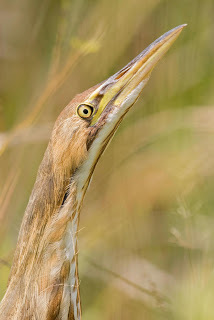 American Bittern (Lynn Cleveland, Audubon.org)
American Bittern (Lynn Cleveland, Audubon.org)
freshwater marshesof cattail reeds and bullrushesto hide still amongand sway like some waving grassbeak to the sky, fooling fish
©2020 Holly Thompson All rights reserved
The American Bittern (Botaurus lentiginosus) is listed under the Massachusetts Endangered Species act as Endangered. See American Bittern in the Mass Wildlife’s Natural Heritage and Endangered Species Program.
Write!What species are Endangered, Threatened or of Special Concern where you live? What information can you find about them? What hopes can you imagine for them? Challenge yourself and write your own set of hope poems for endangered and threatened species near you.
Why? Why write these hope poems? Writing a poem about a plant or animal is like making a sketch--it's a form of intense study and close attention--in this case, a study of endangered or threatened wildlife and their habitats wherever we live or are sheltering. To create a hope poem, we need to find empathy for the plant or animal, try to think from their perspective, then try to puzzle words together into a poem to convey hopes. A hope poem is a mindfulness exercise at this time when hope is something we all need.
These are my hope poems for #NationalPoetryMonth2020 so far:
16. American Bittern
15. American Bumble Bee
14. Great Laurel
13. Humpback Whale
12. Showy Lady's Slipper
11. Pied-billed Grebe10. Frosted Elfin 9. Britton’s Violet8. Little Brown Bat7. Eastern Box Turtle6. Short-eared Owl5. Foxtail Clubmoss4. Eastern Ratsnake3. Piping Plover2. Eastern Spadefoot1. Yellow Oak
Holly Thompson (www.hatbooks.com) is an author who lives in Japan but grew up in Massachusetts where she is now sheltering during the coronavirus pandemic, getting outside to walk and observe wildlife whenever she can.

Hopes for an American Bittern
 American Bittern (Lynn Cleveland, Audubon.org)
American Bittern (Lynn Cleveland, Audubon.org)freshwater marshesof cattail reeds and bullrushesto hide still amongand sway like some waving grassbeak to the sky, fooling fish
©2020 Holly Thompson All rights reserved
The American Bittern (Botaurus lentiginosus) is listed under the Massachusetts Endangered Species act as Endangered. See American Bittern in the Mass Wildlife’s Natural Heritage and Endangered Species Program.
Write!What species are Endangered, Threatened or of Special Concern where you live? What information can you find about them? What hopes can you imagine for them? Challenge yourself and write your own set of hope poems for endangered and threatened species near you.
Why? Why write these hope poems? Writing a poem about a plant or animal is like making a sketch--it's a form of intense study and close attention--in this case, a study of endangered or threatened wildlife and their habitats wherever we live or are sheltering. To create a hope poem, we need to find empathy for the plant or animal, try to think from their perspective, then try to puzzle words together into a poem to convey hopes. A hope poem is a mindfulness exercise at this time when hope is something we all need.
These are my hope poems for #NationalPoetryMonth2020 so far:
16. American Bittern
15. American Bumble Bee
14. Great Laurel
13. Humpback Whale
12. Showy Lady's Slipper
11. Pied-billed Grebe10. Frosted Elfin 9. Britton’s Violet8. Little Brown Bat7. Eastern Box Turtle6. Short-eared Owl5. Foxtail Clubmoss4. Eastern Ratsnake3. Piping Plover2. Eastern Spadefoot1. Yellow Oak
Holly Thompson (www.hatbooks.com) is an author who lives in Japan but grew up in Massachusetts where she is now sheltering during the coronavirus pandemic, getting outside to walk and observe wildlife whenever she can.

Published on April 16, 2020 03:00
April 15, 2020
30 Hope Poems: 15. American Bumble Bee
Day 15 of my National Poetry Month project of 30 Hope Poems focused on native plant and animal species that are protected under the Massachusetts Endangered Species Act.
Hopes for an American Bumble Bee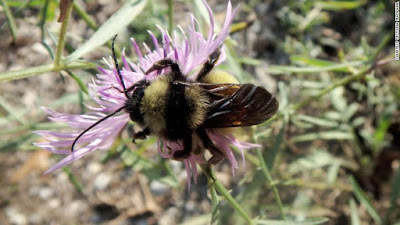 American Bumble Bee (photo: via CNN by @VJMacPhail)
American Bumble Bee (photo: via CNN by @VJMacPhail)
nectar fit for a queen
to start a matted nest
in a dense mound of hay
or open field grass
larval meals of pollen
and nectar from clover heads
cow's vetch, St. John's wort
sunflowers, goldenrod and boneset
dutiful daughters to work
long days, forage, tend to the needs
of the multiplying young
and protect the growing brood
toward more healthy colonies
and fair compensation
in meadows safe and unsprayed
for all employee bees
©2020 Holly Thompson All rights reserved
The American Bumble Bee (Bombus pensylvanicus) is listed under the Massachusetts Endangered Species act as Endangered. See American Bumblebee in the Mass Wildlife’s Natural Heritage and Endangered Species Program.
Write!What species are Endangered, Threatened or of Special Concern where you live? What information can you find about them? What hopes can you imagine for them? Challenge yourself and write your own set of hope poems for endangered and threatened species near you.
Why? Why write these hope poems? Writing a poem about a plant or animal is like making a sketch--it's a form of intense study and close attention--in this case, a study of endangered or threatened wildlife and their habitats wherever we live or are sheltering. To create a hope poem, we need to find empathy for the plant or animal, try to think from their perspective, then try to puzzle words together into a poem to convey hopes. A hope poem is a mindfulness exercise at this time when hope is something we all need.
These are my hope poems for #NationalPoetryMonth2020 so far:
15. American Bumble Bee
14. Great Laurel
13. Humpback Whale
12. Showy Lady's Slipper
11. Pied-billed Grebe10. Frosted Elfin 9. Britton’s Violet8. Little Brown Bat7. Eastern Box Turtle6. Short-eared Owl5. Foxtail Clubmoss4. Eastern Ratsnake3. Piping Plover2. Eastern Spadefoot1. Yellow Oak
Holly Thompson (www.hatbooks.com) is an author who lives in Japan but grew up in Massachusetts where she is now sheltering during the coronavirus pandemic, getting outside to walk and observe wildlife whenever she can.

Hopes for an American Bumble Bee
 American Bumble Bee (photo: via CNN by @VJMacPhail)
American Bumble Bee (photo: via CNN by @VJMacPhail)nectar fit for a queen
to start a matted nest
in a dense mound of hay
or open field grass
larval meals of pollen
and nectar from clover heads
cow's vetch, St. John's wort
sunflowers, goldenrod and boneset
dutiful daughters to work
long days, forage, tend to the needs
of the multiplying young
and protect the growing brood
toward more healthy colonies
and fair compensation
in meadows safe and unsprayed
for all employee bees
©2020 Holly Thompson All rights reserved
The American Bumble Bee (Bombus pensylvanicus) is listed under the Massachusetts Endangered Species act as Endangered. See American Bumblebee in the Mass Wildlife’s Natural Heritage and Endangered Species Program.
Write!What species are Endangered, Threatened or of Special Concern where you live? What information can you find about them? What hopes can you imagine for them? Challenge yourself and write your own set of hope poems for endangered and threatened species near you.
Why? Why write these hope poems? Writing a poem about a plant or animal is like making a sketch--it's a form of intense study and close attention--in this case, a study of endangered or threatened wildlife and their habitats wherever we live or are sheltering. To create a hope poem, we need to find empathy for the plant or animal, try to think from their perspective, then try to puzzle words together into a poem to convey hopes. A hope poem is a mindfulness exercise at this time when hope is something we all need.
These are my hope poems for #NationalPoetryMonth2020 so far:
15. American Bumble Bee
14. Great Laurel
13. Humpback Whale
12. Showy Lady's Slipper
11. Pied-billed Grebe10. Frosted Elfin 9. Britton’s Violet8. Little Brown Bat7. Eastern Box Turtle6. Short-eared Owl5. Foxtail Clubmoss4. Eastern Ratsnake3. Piping Plover2. Eastern Spadefoot1. Yellow Oak
Holly Thompson (www.hatbooks.com) is an author who lives in Japan but grew up in Massachusetts where she is now sheltering during the coronavirus pandemic, getting outside to walk and observe wildlife whenever she can.

Published on April 15, 2020 07:00
April 14, 2020
30 Hope Poems: 14. Great Laurel
Day 14 of my National Poetry Month project of 30 Hope Poems focused on native plant and animal species that are protected under the Massachusetts Endangered Species Act.
Hopes for a Great Laurel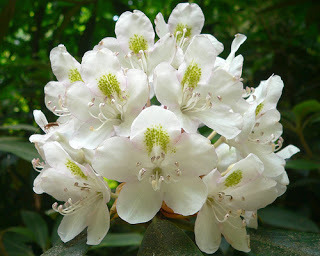 Great Laurel (Wikipedia)
Great Laurel (Wikipedia)
an overhead canopyfor dappled shadenear a bog, a pondor maple swamp
space to spread outfor a sub-canopyroom to grow tallfrom shrub to tree
decent sun for abroadleaf evergreenthat in times of coldjust rolls up its leaves
not so much snowas to break the branchesnot too much heat, justthe right touch of dampness
for clusters of bloomswhite and tinged rosywith soft landing padsfor those visiting bees
©2020 Holly Thompson All rights reserved
The Great Laurel (Rhododendron maximum) or is listed under the Massachusetts Endangered Species act as Threatened. See Great Laurel in the Mass Wildlife’s Natural Heritage and Endangered Species Program.
Write!What species are Endangered, Threatened or of Special Concern where you live? What information can you find about them? What hopes can you imagine for them? Challenge yourself and write your own set of hope poems for endangered and threatened species near you.
Why? Why write these hope poems? Writing a poem about a plant or animal is like making a sketch--it's a form of intense study and close attention--in this case, a study of endangered or threatened wildlife and their habitats wherever we live or are sheltering. To create a hope poem, we need to find empathy for the plant or animal, try to think from their perspective, then try to puzzle words together into a poem to convey hopes. A hope poem is a mindfulness exercise at this time when hope is something we all need.
These are my hope poems for #NationalPoetryMonth2020 so far:
14. Great Laurel
13. Humpback Whale
12. Showy Lady's Slipper
11. Pied-billed Grebe10. Frosted Elfin 9. Britton’s Violet8. Little Brown Bat7. Eastern Box Turtle6. Short-eared Owl5. Foxtail Clubmoss4. Eastern Ratsnake3. Piping Plover2. Eastern Spadefoot1. Yellow Oak
Holly Thompson (www.hatbooks.com) is an author who lives in Japan but grew up in Massachusetts where she is now sheltering during the coronavirus pandemic, getting outside to walk and observe wildlife whenever she can.

Hopes for a Great Laurel
 Great Laurel (Wikipedia)
Great Laurel (Wikipedia)an overhead canopyfor dappled shadenear a bog, a pondor maple swamp
space to spread outfor a sub-canopyroom to grow tallfrom shrub to tree
decent sun for abroadleaf evergreenthat in times of coldjust rolls up its leaves
not so much snowas to break the branchesnot too much heat, justthe right touch of dampness
for clusters of bloomswhite and tinged rosywith soft landing padsfor those visiting bees
©2020 Holly Thompson All rights reserved
The Great Laurel (Rhododendron maximum) or is listed under the Massachusetts Endangered Species act as Threatened. See Great Laurel in the Mass Wildlife’s Natural Heritage and Endangered Species Program.
Write!What species are Endangered, Threatened or of Special Concern where you live? What information can you find about them? What hopes can you imagine for them? Challenge yourself and write your own set of hope poems for endangered and threatened species near you.
Why? Why write these hope poems? Writing a poem about a plant or animal is like making a sketch--it's a form of intense study and close attention--in this case, a study of endangered or threatened wildlife and their habitats wherever we live or are sheltering. To create a hope poem, we need to find empathy for the plant or animal, try to think from their perspective, then try to puzzle words together into a poem to convey hopes. A hope poem is a mindfulness exercise at this time when hope is something we all need.
These are my hope poems for #NationalPoetryMonth2020 so far:
14. Great Laurel
13. Humpback Whale
12. Showy Lady's Slipper
11. Pied-billed Grebe10. Frosted Elfin 9. Britton’s Violet8. Little Brown Bat7. Eastern Box Turtle6. Short-eared Owl5. Foxtail Clubmoss4. Eastern Ratsnake3. Piping Plover2. Eastern Spadefoot1. Yellow Oak
Holly Thompson (www.hatbooks.com) is an author who lives in Japan but grew up in Massachusetts where she is now sheltering during the coronavirus pandemic, getting outside to walk and observe wildlife whenever she can.

Published on April 14, 2020 01:00
April 13, 2020
30 Hope Poems: 13. Humpback Whale
Day 13 of my National Poetry Month project of 30 Hope Poems focused on native plant and animal species that are protected under the Massachusetts Endangered Species Act.
Hopes for a Humpback Whale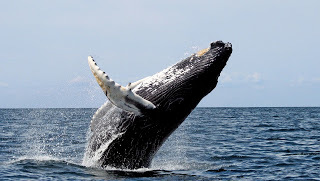 Humpback whale breaching (photo: Whit Welles, Wikipedia)
Humpback whale breaching (photo: Whit Welles, Wikipedia)
a safe journey northwith calves in a groupfrom the warm Caribbeanto the cool Gulf of Maine
rich feeding groundsfull of herring and krillto herd togethergulp in and filter
no gear entanglementsno excessive noisesno sudden ship strikesno injured flukes
just room to breachand fin slap in peaceor float like a logand spyhop in fog one eye out for sharksand enemy orcastangles of garbageand tour boats too close
seekingclean waters to spoutan abundance of planktonthick blubber to lastthe long winter fast
©2020 Holly Thompson All rights reserved
The Humpback Whale (Megaptera novaeangliae) is listed under the Massachusetts Endangered Species act as Endangered. See Humpback Whale n the Mass Wildlife’s Natural Heritage and Endangered Species Program.
Write!What species are Endangered, Threatened or of Special Concern where you live? What information can you find about them? What hopes can you imagine for them? Challenge yourself and write your own set of hope poems for endangered and threatened species near you.
Why? Why write these hope poems? Writing a poem about a plant or animal is like making a sketch--it's a form of intense study and close attention--in this case, a study of endangered or threatened wildlife and their habitats wherever we live or are sheltering. To create a hope poem, we need to find empathy for the plant or animal, try to think from their perspective, then try to puzzle words together into a poem to convey hopes. A hope poem is a mindfulness exercise at this time when hope is something we all need.
These are my hope poems for #NationalPoetryMonth so far:
13. Humpback Whale
12. Showy Lady's Slipper
11. Pied-billed Grebe10. Frosted Elfin 9. Britton’s Violet8. Little Brown Bat7. Eastern Box Turtle6. Short-eared Owl5. Foxtail Clubmoss4. Eastern Ratsnake3. Piping Plover2. Eastern Spadefoot1. Yellow Oak
Holly Thompson (www.hatbooks.com) is an author who lives in Japan but grew up in Massachusetts where she is now sheltering during the coronavirus pandemic, getting outside to walk and observe wildlife whenever she can.

Hopes for a Humpback Whale
 Humpback whale breaching (photo: Whit Welles, Wikipedia)
Humpback whale breaching (photo: Whit Welles, Wikipedia)a safe journey northwith calves in a groupfrom the warm Caribbeanto the cool Gulf of Maine
rich feeding groundsfull of herring and krillto herd togethergulp in and filter
no gear entanglementsno excessive noisesno sudden ship strikesno injured flukes
just room to breachand fin slap in peaceor float like a logand spyhop in fog one eye out for sharksand enemy orcastangles of garbageand tour boats too close
seekingclean waters to spoutan abundance of planktonthick blubber to lastthe long winter fast
©2020 Holly Thompson All rights reserved
The Humpback Whale (Megaptera novaeangliae) is listed under the Massachusetts Endangered Species act as Endangered. See Humpback Whale n the Mass Wildlife’s Natural Heritage and Endangered Species Program.
Write!What species are Endangered, Threatened or of Special Concern where you live? What information can you find about them? What hopes can you imagine for them? Challenge yourself and write your own set of hope poems for endangered and threatened species near you.
Why? Why write these hope poems? Writing a poem about a plant or animal is like making a sketch--it's a form of intense study and close attention--in this case, a study of endangered or threatened wildlife and their habitats wherever we live or are sheltering. To create a hope poem, we need to find empathy for the plant or animal, try to think from their perspective, then try to puzzle words together into a poem to convey hopes. A hope poem is a mindfulness exercise at this time when hope is something we all need.
These are my hope poems for #NationalPoetryMonth so far:
13. Humpback Whale
12. Showy Lady's Slipper
11. Pied-billed Grebe10. Frosted Elfin 9. Britton’s Violet8. Little Brown Bat7. Eastern Box Turtle6. Short-eared Owl5. Foxtail Clubmoss4. Eastern Ratsnake3. Piping Plover2. Eastern Spadefoot1. Yellow Oak
Holly Thompson (www.hatbooks.com) is an author who lives in Japan but grew up in Massachusetts where she is now sheltering during the coronavirus pandemic, getting outside to walk and observe wildlife whenever she can.

Published on April 13, 2020 01:00
April 12, 2020
30 Hope Poems: 12. Showy Lady's Slipper
Day 12 of my National Poetry Month project of 30 Hope Poems focused on native plant and animal species that are protected under the Massachusetts Endangered Species Act.
 Showy Lady's Slipper (Wikipedia)Hopes for a Showy Lady’s Slipper
Showy Lady's Slipper (Wikipedia)Hopes for a Showy Lady’s Slipper
someone to noticemy long-ribbed leaves and coverme with a wire cagebefore deer arrive to grazeupon my blooming magenta
©2020 Holly Thompson All rights reserved
The Showy Lady’s Slipper (Cypripedium reginae) is listed under the Massachusetts Endangered Species act as Endangered. See Showy Lady’s Slipper the Mass Wildlife’s Natural Heritage and Endangered Species Program.
Write!What species are Endangered, Threatened or of Special Concern where you live? What information can you find about them? What hopes can you imagine for them? Challenge yourself and write your own set of hope poems for endangered and threatened species near you.
Why? Why write these hope poems? Writing a poem about a plant or animal is like making a sketch--it's a form of intense study and close attention--in this case, a study of endangered or threatened wildlife and their habitats wherever we live or are sheltering. To create a hope poem, we need to find empathy for the plant or animal, try to think from their perspective, then try to puzzle words together into a poem to convey hopes. A hope poem is a mindfulness exercise at this time when hope is something we all need.
These are my hope poems for #NationalPoetryMonth so far:
12. Showy Lady's Slipper
11. Pied-billed Grebe10. Frosted Elfin 9. Britton’s Violet8. Little Brown Bat7. Eastern Box Turtle6. Short-eared Owl5. Foxtail Clubmoss4. Eastern Ratsnake3. Piping Plover2. Eastern Spadefoot1. Yellow Oak
Holly Thompson (www.hatbooks.com) is an author who lives in Japan but grew up in Massachusetts where she is now sheltering during the coronavirus pandemic, getting outside to walk and observe wildlife whenever she can.
 Showy Lady's Slipper (Wikipedia)Hopes for a Showy Lady’s Slipper
Showy Lady's Slipper (Wikipedia)Hopes for a Showy Lady’s Slipper someone to noticemy long-ribbed leaves and coverme with a wire cagebefore deer arrive to grazeupon my blooming magenta
©2020 Holly Thompson All rights reserved
The Showy Lady’s Slipper (Cypripedium reginae) is listed under the Massachusetts Endangered Species act as Endangered. See Showy Lady’s Slipper the Mass Wildlife’s Natural Heritage and Endangered Species Program.
Write!What species are Endangered, Threatened or of Special Concern where you live? What information can you find about them? What hopes can you imagine for them? Challenge yourself and write your own set of hope poems for endangered and threatened species near you.
Why? Why write these hope poems? Writing a poem about a plant or animal is like making a sketch--it's a form of intense study and close attention--in this case, a study of endangered or threatened wildlife and their habitats wherever we live or are sheltering. To create a hope poem, we need to find empathy for the plant or animal, try to think from their perspective, then try to puzzle words together into a poem to convey hopes. A hope poem is a mindfulness exercise at this time when hope is something we all need.
These are my hope poems for #NationalPoetryMonth so far:
12. Showy Lady's Slipper
11. Pied-billed Grebe10. Frosted Elfin 9. Britton’s Violet8. Little Brown Bat7. Eastern Box Turtle6. Short-eared Owl5. Foxtail Clubmoss4. Eastern Ratsnake3. Piping Plover2. Eastern Spadefoot1. Yellow Oak
Holly Thompson (www.hatbooks.com) is an author who lives in Japan but grew up in Massachusetts where she is now sheltering during the coronavirus pandemic, getting outside to walk and observe wildlife whenever she can.
Published on April 12, 2020 01:00
April 11, 2020
30 Hope Poems: 11. Pied-billed Grebe
Day 11 of my National Poetry Month project of 30 Hope Poems focused on native plant and animal species that are protected under the Massachusetts Endangered Species Act.
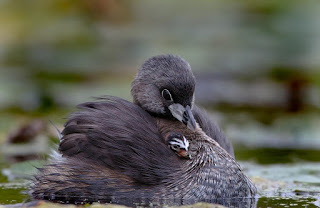 Pied-billed Grebe (Tim Kuhn, Mass Audubon)Hopes for a Pied-billed Grebe
Pied-billed Grebe (Tim Kuhn, Mass Audubon)Hopes for a Pied-billed Grebe
wetland quiet for a floating nestset right at water’s edgea pond or marsh, fresh or saltanywhere that’s secret forconcealing eggs and gliding offto feed on fish and insects
a brood of young to feed with feathersand climb upon your backand teach them how to float and sinkand learn the special knackof running over open water thenfly! when under attack
a partner who stays to help throughoutthose busy rearing daysa season when all the young surviveto fly to warmer placesthen gather as flocks on open baysto dive all day for prey
©2020 Holly Thompson All rights reserved
The Pied-billed Grebe (Podilymbus podiceps) is listed under the Massachusetts Endangered Species act as Endangered. See Pied-billed Grebe in the Mass Wildlife’s Natural Heritage and Endangered Species Program.
Write!What species are Endangered, Threatened or of Special Concern where you live? What information can you find about them? What hopes can you imagine for them? Challenge yourself and write your own set of hope poems for endangered and threatened species near you.
Why? Why write these hope poems? Writing a poem about a plant or animal is like making a sketch--it's a form of intense study and close attention--in this case, a study of endangered or threatened wildlife and their habitats wherever we live or are sheltering. To create a hope poem, we need to find empathy for the plant or animal, try to think from their perspective, then try to puzzle words together into a poem to convey hopes. A hope poem is a mindfulness exercise at this time when hope is something we all need.
Here are my hope poems for #NationalPoetryMonth so far:
11. Pied-billed Grebe10. Frosted Elfin 9. Britton’s Violet8. Little Brown Bat7. Eastern Box Turtle6. Short-eared Owl5. Foxtail Clubmoss4. Eastern Ratsnake3. Piping Plover2. Eastern Spadefoot1. Yellow Oak
Holly Thompson (www.hatbooks.com) is an author who lives in Japan but grew up in Massachusetts where she is now sheltering during the coronavirus pandemic, getting outside to walk and observe wildlife whenever she can.
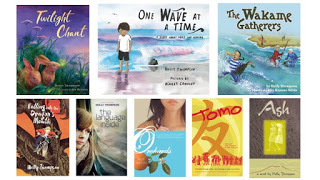
 Pied-billed Grebe (Tim Kuhn, Mass Audubon)Hopes for a Pied-billed Grebe
Pied-billed Grebe (Tim Kuhn, Mass Audubon)Hopes for a Pied-billed Grebe wetland quiet for a floating nestset right at water’s edgea pond or marsh, fresh or saltanywhere that’s secret forconcealing eggs and gliding offto feed on fish and insects
a brood of young to feed with feathersand climb upon your backand teach them how to float and sinkand learn the special knackof running over open water thenfly! when under attack
a partner who stays to help throughoutthose busy rearing daysa season when all the young surviveto fly to warmer placesthen gather as flocks on open baysto dive all day for prey
©2020 Holly Thompson All rights reserved
The Pied-billed Grebe (Podilymbus podiceps) is listed under the Massachusetts Endangered Species act as Endangered. See Pied-billed Grebe in the Mass Wildlife’s Natural Heritage and Endangered Species Program.
Write!What species are Endangered, Threatened or of Special Concern where you live? What information can you find about them? What hopes can you imagine for them? Challenge yourself and write your own set of hope poems for endangered and threatened species near you.
Why? Why write these hope poems? Writing a poem about a plant or animal is like making a sketch--it's a form of intense study and close attention--in this case, a study of endangered or threatened wildlife and their habitats wherever we live or are sheltering. To create a hope poem, we need to find empathy for the plant or animal, try to think from their perspective, then try to puzzle words together into a poem to convey hopes. A hope poem is a mindfulness exercise at this time when hope is something we all need.
Here are my hope poems for #NationalPoetryMonth so far:
11. Pied-billed Grebe10. Frosted Elfin 9. Britton’s Violet8. Little Brown Bat7. Eastern Box Turtle6. Short-eared Owl5. Foxtail Clubmoss4. Eastern Ratsnake3. Piping Plover2. Eastern Spadefoot1. Yellow Oak
Holly Thompson (www.hatbooks.com) is an author who lives in Japan but grew up in Massachusetts where she is now sheltering during the coronavirus pandemic, getting outside to walk and observe wildlife whenever she can.

Published on April 11, 2020 06:00
April 10, 2020
Read-Aloud of The Wakame Gatherers
Many thanks to the Five College Center for East Asian Studies for this opportunity to present a read-aloud of The Wakame Gatherers, illustrated by Kazumi Wilds. A picture book edition is coming soon!
Here is the full intro to the read-aloud from FCCEAS:
*************
The Wakame Gatherers Read-Aloud with author Holly ThompsonThe Five College Center for East Asian Studies is pleased to present Holly Thompson reading her picture book The Wakame Gatherers (Shen’s/Lee&Low, October 2007; coming in paperback this fall). The video also includes a short introduction to wakame seaweed. From now until June 30, 2020, teachers and parents can share this book with children.
Go to https://www.youtube.com/watch?v=pKV3HdzprWA&t=15s
Teacher’s guide https://www.leeandlow.com/books/the-wakame-gatherers/teachers_guideThe Five College Center for East Asian Studies is a national coordinating site for the National Consortium for Teaching about Asia (NCTA), which is supported by a generous grant from the Freeman Foundation. Learn more at www.fivecolleges.edu/fcceas and nctasia.org.Join us on Facebook www.facebook.com/FCCEAS; www.facebook.com/NCTAsia; and Twitter twitter.com/NCTAsia_You can follow Holly Thompson at www.hatbooks.com; twitter.com/hatbooks; www.facebook.com/holly.thompson#wakame #readaloud #distancelearning #diversebooks #childrensbooks #picturebooks #childrensbooks #Kamakura #JapanThe Wakame Gatherers: A bicultural girl in Japan goes wakame seaweed gathering with her Japanese and American grandmothers. Nanami must serve as translator for the two women, whom she comes to understand were at war when they were her age. Included after the story are an author’s note about wakame, a glossary of Japanese words used, and recipes for wakame by Nanami and each of her grandmothers.Holly Thompson was raised in New England and earned a B.A. in biology from Mount Holyoke College and an M.A. in English from New York University's Creative Writing Program. Longtime resident of Japan, she teaches creative writing at Yokohama City University, U.C. Berkeley Extension, and Boston's Grub Street Creative Writing Center, and presents at schools worldwide.*************
So buy, order or gather some wakame and enjoy!
Here is the full intro to the read-aloud from FCCEAS:
*************
The Wakame Gatherers Read-Aloud with author Holly ThompsonThe Five College Center for East Asian Studies is pleased to present Holly Thompson reading her picture book The Wakame Gatherers (Shen’s/Lee&Low, October 2007; coming in paperback this fall). The video also includes a short introduction to wakame seaweed. From now until June 30, 2020, teachers and parents can share this book with children.
Go to https://www.youtube.com/watch?v=pKV3HdzprWA&t=15s
Teacher’s guide https://www.leeandlow.com/books/the-wakame-gatherers/teachers_guideThe Five College Center for East Asian Studies is a national coordinating site for the National Consortium for Teaching about Asia (NCTA), which is supported by a generous grant from the Freeman Foundation. Learn more at www.fivecolleges.edu/fcceas and nctasia.org.Join us on Facebook www.facebook.com/FCCEAS; www.facebook.com/NCTAsia; and Twitter twitter.com/NCTAsia_You can follow Holly Thompson at www.hatbooks.com; twitter.com/hatbooks; www.facebook.com/holly.thompson#wakame #readaloud #distancelearning #diversebooks #childrensbooks #picturebooks #childrensbooks #Kamakura #JapanThe Wakame Gatherers: A bicultural girl in Japan goes wakame seaweed gathering with her Japanese and American grandmothers. Nanami must serve as translator for the two women, whom she comes to understand were at war when they were her age. Included after the story are an author’s note about wakame, a glossary of Japanese words used, and recipes for wakame by Nanami and each of her grandmothers.Holly Thompson was raised in New England and earned a B.A. in biology from Mount Holyoke College and an M.A. in English from New York University's Creative Writing Program. Longtime resident of Japan, she teaches creative writing at Yokohama City University, U.C. Berkeley Extension, and Boston's Grub Street Creative Writing Center, and presents at schools worldwide.*************
So buy, order or gather some wakame and enjoy!
Published on April 10, 2020 12:05
April 9, 2020
30 Hope Poems: 10. Frosted Elfin
Today is #PoetryFriday and Day 10 of my National Poetry Month project of 30 Hope Poems focused on native plant and animal species that are protected under the Massachusetts Endangered Species Act.
Hopes for a Frosted Elfin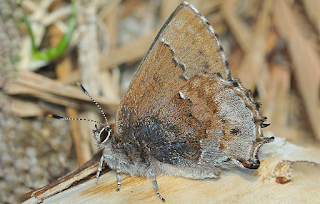 Frosted Elfin (Mass.gov)
Frosted Elfin (Mass.gov)
grassy fieldsof blue violetpromisewith blossomsof lupineor wild indigofor egg layingone bysolitary onethat when caterpillarsemerge theymay nosh on petalsand seedpodsone after anotheruntil it’s timeto bundleinto a pupato overwinterthen emergein springtimeto grassy fieldsof blue violetpromise
©2020 Holly Thompson All rights reserved
The Frosted Elfin (Callophrys irus) is listed under the Massachusetts Endangered Species act as a species of Special Concern. See Frosted Elfin in Mass Wildlife’s Natural Heritage and Endangered Species Program.
Write!What species are Endangered, Threatened or of Special Concern where you live? What information can you find about them? What hopes can you imagine for them? Challenge yourself and write your own set of hope poems for endangered and threatened species near you.
These are my hope poems for #NationalPoetryMonth so far:
10. Frosted Elfin
9. Britton’s Violet8. Little Brown Bat7. Eastern Box Turtle6. Short-eared Owl5. Foxtail Clubmoss4. Eastern Ratsnake3. Piping Plover2. Eastern Spadefoot1. Yellow Oak
Be sure to check out all the #PoetryFriday offerings this week: Amy Ludwig Vanderwater is hosting at The Poetry Farm--be sure to visit the Inlinx link party!
Holly Thompson (www.hatbooks.com) is an author who lives in Japan but grew up in Massachusetts where she is now sheltering during the coronavirus pandemic, getting outside to walk and observe wildlife whenever she can.
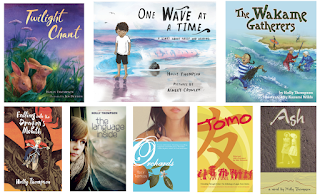
Hopes for a Frosted Elfin
 Frosted Elfin (Mass.gov)
Frosted Elfin (Mass.gov)grassy fieldsof blue violetpromisewith blossomsof lupineor wild indigofor egg layingone bysolitary onethat when caterpillarsemerge theymay nosh on petalsand seedpodsone after anotheruntil it’s timeto bundleinto a pupato overwinterthen emergein springtimeto grassy fieldsof blue violetpromise
©2020 Holly Thompson All rights reserved
The Frosted Elfin (Callophrys irus) is listed under the Massachusetts Endangered Species act as a species of Special Concern. See Frosted Elfin in Mass Wildlife’s Natural Heritage and Endangered Species Program.
Write!What species are Endangered, Threatened or of Special Concern where you live? What information can you find about them? What hopes can you imagine for them? Challenge yourself and write your own set of hope poems for endangered and threatened species near you.
These are my hope poems for #NationalPoetryMonth so far:
10. Frosted Elfin
9. Britton’s Violet8. Little Brown Bat7. Eastern Box Turtle6. Short-eared Owl5. Foxtail Clubmoss4. Eastern Ratsnake3. Piping Plover2. Eastern Spadefoot1. Yellow Oak
Be sure to check out all the #PoetryFriday offerings this week: Amy Ludwig Vanderwater is hosting at The Poetry Farm--be sure to visit the Inlinx link party!
Holly Thompson (www.hatbooks.com) is an author who lives in Japan but grew up in Massachusetts where she is now sheltering during the coronavirus pandemic, getting outside to walk and observe wildlife whenever she can.

Published on April 09, 2020 22:00
30 Hope Poems: 9. Britton's Violet
Day 9 of my National Poetry Month project of 30 Hope Poems focused on native plant and animal species that are protected under the Massachusetts Endangered Species Act.
Hopes for Britton’s Violet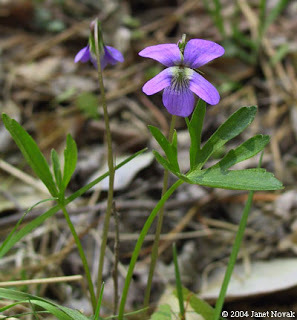 Britton's Violet (CT-botanical-society.org)
Britton's Violet (CT-botanical-society.org)
floodplainsforest clearingscoast glades and pine barrensspace to splay lobed leaves to the sunand blossom
©2020 Holly Thompson All rights reserved
The Britton’s Violet (Viola brittoniana) is listed under the Massachusetts Endangered Species act as Threatened. See Britton’s Violet in Mass Wildlife’s Natural Heritage and Endangered Species Program.
Write!
What species are Endangered, Threatened or of Special Concern where you live? What information can you find about them? What hopes can you imagine for them? Challenge yourself and write your own set of hope poems for endangered and threatened species near you.
Holly Thompson (www.hatbooks.com) is an author who lives in Japan but grew up in Massachusetts where she is now sheltering during the coronavirus pandemic, getting outside to walk and observe wildlife whenever she can.
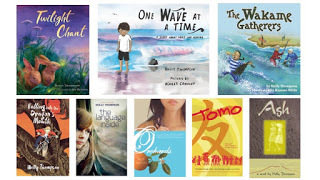
Hopes for Britton’s Violet
 Britton's Violet (CT-botanical-society.org)
Britton's Violet (CT-botanical-society.org)floodplainsforest clearingscoast glades and pine barrensspace to splay lobed leaves to the sunand blossom
©2020 Holly Thompson All rights reserved
The Britton’s Violet (Viola brittoniana) is listed under the Massachusetts Endangered Species act as Threatened. See Britton’s Violet in Mass Wildlife’s Natural Heritage and Endangered Species Program.
Write!
What species are Endangered, Threatened or of Special Concern where you live? What information can you find about them? What hopes can you imagine for them? Challenge yourself and write your own set of hope poems for endangered and threatened species near you.
Holly Thompson (www.hatbooks.com) is an author who lives in Japan but grew up in Massachusetts where she is now sheltering during the coronavirus pandemic, getting outside to walk and observe wildlife whenever she can.

Published on April 09, 2020 04:00
April 8, 2020
30 Hope Poems: 8. Little Brown Bat
Day 8 of my National Poetry Month project of 30 Hope Poems focused on native plant and animal species that are protected under the Massachusetts Endangered Species Act.
Hopes for a Little Brown Bat Little Brown Bat (Bill Byrne Mass Wildlife)
Little Brown Bat (Bill Byrne Mass Wildlife)
an eave or tree to hang beneathand shelter through the day
a stream or pond to forage nearand echolocate prey
spiders, stonefliesbeetles, mayfliesmosquitoes, fruit fliesbeetles, caddisflies
then a cave not over-crowdedto safely hibernate
the end of white-nose syndromeand improved survival rate
©2020 Holly Thompson All rights reserved
The Little Brown Bat (Myotis lucifugus) is listed under the Massachusetts Endangered Species act as Endangered. See Little Brown Bat in Mass Wildlife’s Natural Heritage and Endangered Species Program.
Write!What species are Endangered, Threatened or of Special Concern where you live? What information can you find about them? What hopes can you imagine for them? Write your own hope poem and post in the comments to share.
Holly Thompson (www.hatbooks.com) is an author who lives in Japan but grew up in Massachusetts where she is now sheltering during the coronavirus pandemic, getting outside to walk and observe wildlife whenever she can.

Hopes for a Little Brown Bat
 Little Brown Bat (Bill Byrne Mass Wildlife)
Little Brown Bat (Bill Byrne Mass Wildlife)an eave or tree to hang beneathand shelter through the day
a stream or pond to forage nearand echolocate prey
spiders, stonefliesbeetles, mayfliesmosquitoes, fruit fliesbeetles, caddisflies
then a cave not over-crowdedto safely hibernate
the end of white-nose syndromeand improved survival rate
©2020 Holly Thompson All rights reserved
The Little Brown Bat (Myotis lucifugus) is listed under the Massachusetts Endangered Species act as Endangered. See Little Brown Bat in Mass Wildlife’s Natural Heritage and Endangered Species Program.
Write!What species are Endangered, Threatened or of Special Concern where you live? What information can you find about them? What hopes can you imagine for them? Write your own hope poem and post in the comments to share.
Holly Thompson (www.hatbooks.com) is an author who lives in Japan but grew up in Massachusetts where she is now sheltering during the coronavirus pandemic, getting outside to walk and observe wildlife whenever she can.

Published on April 08, 2020 05:00



